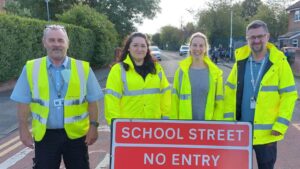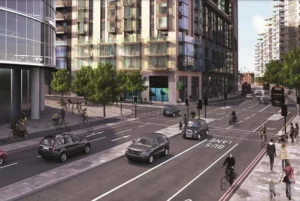The Mayor of London, Sadiq Khan, has hailed the success of his School Streets programme as he announced that across London there are now more than 500 School Streets in place.
Thanks to School Streets and other measures, walking is now the main way 58 per cent of children aged 5-11 in London get to school, according to TfL analysis.
Car trips to school have a huge impact on congestion – increasing toxic air pollution, carbon emissions and road danger. Before the pandemic, a quarter of weekday morning peak car trips were for school drop-off, meaning the rush hour around schools can be busy, polluted and dangerous. With London having the highest levels of childhood obesity in England, the Mayor believes it is vital that children are able to walk, cycle or scoot to school so they build exercise into their daily lives.
School Streets – restricting car access to the street outside a school gate to cars at drop off and pick up times – are a new way of making it safer, cleaner and easier for children to get to school on foot, by bike or by scooter. The first School Street was launched in Camden in 2017, and in 2019 there were less than 90 School Streets in London, across 20 boroughs. Walking and cycling have experienced a huge increase in recent years, with over 400 School Streets being introduced across the capital since the start of the pandemic – 372 funded with support from the Mayor and TfL and the rest funded by boroughs – a rate of more than three a week. There are now 511 School Streets in London in total – at almost a quarter of primary schools – with more being installed almost every month.
Research published by City Hall, making use of the Breathe London air quality monitoring network, found that School Streets reduce nitrogen dioxide by up to 23 per cent during morning drop off. A separate study carried out for TfL found that School Streets have strong support from Londoners, with 77 per cent of parents and carers from a sample of 35 schools expressing support for the changes being kept in the long term, subject to consultation.
Having exceeded the target set in TfL’s 2018 Walking Action Plan to increase the proportion of walking trips made to primary schools to 57 per cent by 2024, TfL is now setting a new stretch target of 60 per cent of primary children walking to school by 2026. Activity through STARS, TfL’s accreditation scheme for London schools and nurseries, is focused on encouraging active travel to school, in line with the Walking Action Plan. Over 1400 schools have STARS accreditation, reaching 680,000 pupils. To achieve this new goal, TfL will focus on doubling the number of gold-accredited schools from 500 to 1,000 by 2024 and continuing to support boroughs delivery of School Streets and low traffic neighbourhoods should there be funding available to do so.
London’s boroughs have drawn up plans for a further 80 School Streets to be delivered in the 2022/23 financial year, dependent on funding from the Government. Many boroughs have already seen huge success from their School Streets:
·Monitoring data from Islington Council found that, even after taking the impact of Covid on transport into account, there was a reduction in traffic within new School Streets zones between August 2020 and July 2021 of 50 per cent during the morning school run, and by 39 per cent during afternoon pick-up times.
·At Thornhill Primary School in Islington there was an 11 per cent rise in the number of pupils walking, cycling and scooting to school between May 2019 and August 2021, with the proportion of children travelling by car falling from 17 per cent to eight per cent during the same period.
·Hackney Council’s School Streets pilot found, between 2017 and 2019, a 51 per cent increase in cycling to school, a 30 per cent increase in walking and a 74 per cent reduction in tailpipe emissions.
·Tower Hamlets Council is on track to meet its target of 50 School Streets this year with the final phase of consultations underway.
Today the Mayor visited Gayhurst Community School in Hackney, a STARS Gold School which has seen a 10 per cent drop in the number of children being driven to school since joining TfL’s STARS programme – from 17 per cent in 2005 to just 7 per cent today. 92 per cent of the pupil and teachers’ journeys to Gayhurst Community School use active travel, with 71 per cent of journeys walked and 21 per cent cycled.
The Mayor of London, Sadiq Khan, said: “For London to become Net Zero by 2030, we need to reduce motor traffic by a third. The school run accounts for a quarter of morning traffic, so School Streets are a key tool in helping to drive down congestion, air pollution and road danger. They are making a massive difference to our capital’s communities, with more than half of London’s 5-11 year olds now walking to school. We now have more than 500 School Streets across the capital and we know children, parents and councils are keen to introduce even more. TfL has set a new target to get 60 per cent of primary children in London walking to school by 2026. However, we won’t be able to fund schemes like School Streets if TfL has to enter a managed decline scenario due to lack of Government funding. That’s why it’s vital Ministers provide us with the longer-term, capital funding TfL needs so that we can continue this huge success.”
Penny Rees, TfL’s Head of Healthy Streets Investment, said: “Enabling more people to walk and cycle safely is vital to ensuring London’s green recovery from the pandemic. School Streets play an important role in encouraging children to build exercise into their daily lives, which is why we’ve worked closely with councils across the capital to deliver more than 500 schemes so far. It’s fantastic to see the impact these are having on increasing the number of children who walk, cycle and scoot to school and we’ll continue to work with councils to make roads safer for people and families across London.”
TfL continues to support the delivery of School Streets and monitor their impact, and will help transition them from temporary to permanent schemes where appropriate. TfL has commissioned a second phase of School Streets research to see how they can be delivered in a more consistent and effective way across London. The research report will be available later in the Spring.
School Streets are just one of the Healthy Streets initiatives developed by the Mayor and TfL. In Sadiq’s first term, working in partnership with London boroughs, he tripled the network of protected cycle routes, delivering an additional 100km of new and upgraded cycleways during the pandemic, and worked with boroughs to deliver over 100 Low Traffic Neighbourhoods. Roads have also been made safer for vulnerable road users with over half of London’s roads now having a 20mph speed limit.
Mayor of Hackney, Philip Glanville, said: “We’re proud to have pioneered School Streets and now, with 48, Hackney has more than any other borough in London. They are transforming the trip to school for thousands of children in Hackney, reducing toxic air pollution, and supporting kids and their families to walk, cycle and scoot more. We also thank the Mayor of London for his support and funding.
“Recent representative polling in Hackney showed that 7 in 10 people support School Streets and we look forward to continuing to work more schools in the near future to expand this vital network.”
Jemima Hartshorn, Founder of Mums for Lungs said: “This is such good news – thousands of children are now having a healthier, safer and calmer start and end to the school day because their schools, local leaders and the Mayor decided to help protect them. A huge shout-out to all the parents and children who travel actively to school every day too, helping to ensure that London’s air is cleaned up. School Streets play a hugely important part in helping to protect children’s lungs, so we really need more rolled out all over London and the UK – and a proper plan on how to deal with the schools on very polluted roads that cannot be closed.”
TfL’s Travel in London report showed that the proportion of journeys cycled in 2020 accounted for 3.4 per cent of all journeys – a 48 per cent increase since 2019. Cycling mode shares for London residents – the number of trips made by cycling as a percentage of all their trips – were on average around twice as high (5.3 per cent) as they were before the pandemic (2.8 per cent in 2019/20). Cycling at weekends boomed, with the number of journeys regularly double those of equivalent weekends in previous years, and some seeing an increase of over 200 per cent. There was also an increase in the number of trips walked in the capital in 2020, with the proportion of journeys made on foot by Londoners increasing from 21 per cent of all journeys to 30 per cent – a 43 per cent increase since 2019.





















